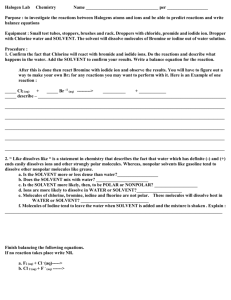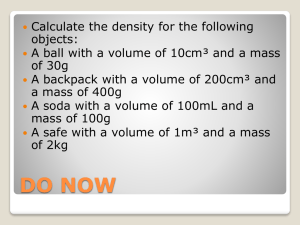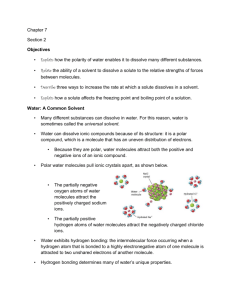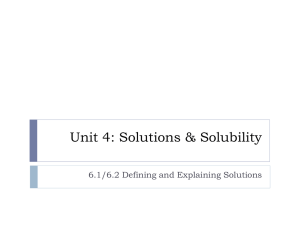Water Chemistry Lab Activities: Experiments & Properties
advertisement
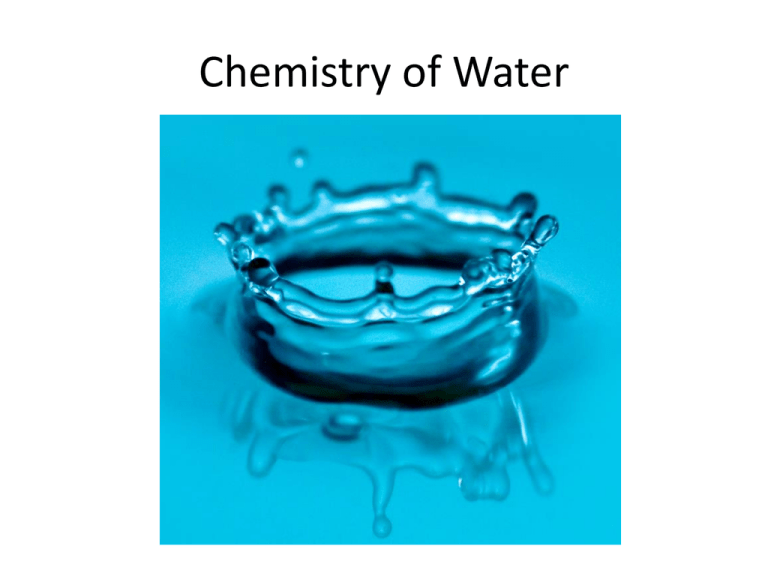
Chemistry of Water Density of Water & Ice Given the following materials, calculate the density of water and ice. Ice Cubes Water Triple Beam Balance 10-ml Graduated Cylinder 25-ml Graduated Cylinder 100-ml Graduated Cylinder Propose an explanation for your findings. What Shape is a Drop Using a pipette, drop a small sample of each of the liquids––water, oil, and soapy water––on a piece of wax paper. Draw the shape and label the shape of the drops made by each of the liquids on your worksheet. Wipe off the wax paper with a clean a paper towel and return everything to the supplies table. Getting Metal to Sink While most people agree that metal is likely to sink like a stone, we all know it is possible to get metal to float. Just look at battleships – great big hunks of steel floating around out at sea. But some metals just don’t seem to want to sink. Look at aluminum foil for example. Take three samples of aluminum foil and a beaker. See what you can do to get that sheet of metal to sink in the container of water provided. Record your observations in your notebook. How to Make A Water Walker Water walkers are any of a number of different invertebrates that can “walk” on water. Read the article Water Walkers. In your lab notebook, write a short summary of the article. Then, using the materials provided, try to make your own water walker. Be sure to include a head, body, and six legs. Hopefully, your water walker will float too!! Sketch your design and record your results in your lab notebook. Heat Capacity Materials: Light Bulb, 2 Beakers, 2 Thermometers, Water Design an experiment to test which heats up faster – air or water. In your lab notebook write up a short procedure. Then collect and record your data. Finally, write a brief conclusion about your results. The Universal Solvent – Part I Because of its high polarity, water is called the universal solvent. A solvent is a substance that dissolves, or breaks apart, another substance (known as a solute). A general rule that determines whether a substance will dissolve in a solvent depends upon its polarity. Polar solvents dissolve polar solutes and nonpolar solvents dissolve nonpolar solutes. In this activity, you will compare the ability of water, alcohol, and vegetable oil to dissolve certain solids. CAUTION: Rubbing alcohol is flammable, an eye irritant, and has fumes. The Universal Solvent – Part II Materials: graduated cylinder, 9 test tubes, test-tube rack, water, alcohol, vegetable oil, sugar, salt, and margarine Procedure: 1. Number your test tubes (TT) 1-9. 2. Pour 10 mL of water into TT marked 1-3. 3. Pour 10 mL of alcohol into TT marked 4-6. 4. Pour 10 mL of vegetable oil into TT marked 7-9. 5. Place a teaspoon of sugar in TT 1, 4, & 7. 6. Place a teaspoon of salt in 2, 5, & 8. 7. Place a small piece of margarine in TT 3, 6, & 9. 8. Cover each TT with your thumb and shake. How well does each solvent dissolve the solute? 9. Observe and record the results in your lab notebook. 10. What conclusions can you make about water as a solvent? Filled to the Brim Fill a mason jar full with water. Predict how many pennies can be added to the glass before it overflows. Add pennies one at a time until the water overflows. Record your results and suggest an explanation for your observations How Do Roots Work Add about one (1”) inch of water to the bottom of a mason jar. Hang a strip of paper towel to the rim of the glass so just the edge of the towel touches the water. Every minute for five minutes, record your observations in your lab notebook. Drowning Mr. Lincoln Materials: Penny, Water, Paper Towel, Pipette Count how many drops of water you can add to the Lincoln side of a penny before the water rolls off the coin. Record your results. Then turn the coin over and repeat the experiment. Suggest an explanation for your results.




